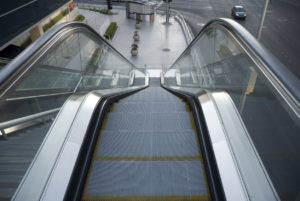Key Points:
- Approximately 17,000 people are injured in elevator or escalator accidents every year.
- Elevator and escalator accidents are often extremely dangerous because of the nature of the incidents.
- According to the common carrier rule, elevator and escalator operators must go beyond just taking reasonable steps to ensure they are safe. The owner has an “extraordinary duty” to be extra careful.
Atlanta is home to thousands of escalators and elevators, which are integral to the infrastructure of apartments, office buildings, shopping centers, airports, and grocery stores. The vast majority of residents and visitors use these machines regularly and without any problems. Unfortunately, despite the routine nature of these rides, accidents can still occur, sometimes resulting in injuries. Whether due to mechanical malfunctions, maintenance oversights, or rare instances of misuse, these incidents underscore the importance of ongoing vigilance and safety protocols.
Who is at Risk of Elevator and Escalator Accidents?
Elevator and escalator accidents can affect anyone, but certain groups are especially vulnerable due to physical limitations or a lack of familiarity with these machines. Young children are particularly at risk, as they may not fully understand the dangers or the proper way to use elevators and escalators. Additionally, their smaller stature increases the likelihood of entrapment or serious falls. Elderly individuals and those with physical disabilities also face increased dangers. The elderly might struggle with mobility and slower reaction times, which can lead to accidents, while people with disabilities may find it challenging to safely navigate the moving steps of an escalator or time the opening and closing of elevator doors.
Maintenance workers who install, repair, and maintain these systems are inherently at risk due to the nature of their job, especially if safety protocols lapse. Moreover, individuals who frequently use escalators and elevators in high-traffic areas, such as shoppers and commuters in malls, airports, and transit stations, are more exposed to potential malfunctions and accidents due to the heavy use these machines endure. Enhancing safety measures and promoting awareness can significantly reduce these risks, ensuring safer use for everyone.
What Types or Forms of Negligence Cause Elevator/Escalator Injuries?
Elevator and escalator injuries can be caused by various forms of negligence, which compromise the safety of these conveyances. Here are some common types of negligence that lead to injuries:
- Poor Maintenance: Failure to regularly inspect and maintain elevators and escalators can lead to mechanical failures, such as abrupt stops or malfunctions that cause accidents.
- Inadequate Staff Training: Insufficient training for operators and maintenance personnel can result in improper handling or delayed response to technical issues, increasing the risk of accidents.
- Defective Design or Manufacturing: Elevators and escalators that are poorly designed or manufactured with defective parts may malfunction, potentially causing injury to passengers.
- Lack of Safety Features: Missing safety measures, such as proper signage, emergency stop buttons, or barriers, can lead to accidents, particularly in high traffic areas.
- Improper Installations or Repairs: Incorrectly installed or improperly repaired components can fail during operation, leading to dangerous situations for users.
- Delayed Response to Known Issues: Ignoring reported problems or delaying repairs can allow hazards to persist, increasing the likelihood of injuries.
Identifying where the negligence is can help identify if who is liable, and if there is a personal injury lawsuit.
Are Most Elevator and Escalator Accidents the Result of User Errors?
For a personal injury lawyer to successfully secure a settlement in cases of elevator or escalator accidents, it’s crucial to establish that the user was properly utilizing the equipment at the time of the accident. This is often a significant challenge, particularly in accidents involving children, where parental supervision may be questioned. In many of these instances, if the child was not using the elevator or escalator in a conventional manner, the liability might shift to the caregiver for negligence.
However, if it can be demonstrated that an individual was using the elevator or escalator correctly and an injury occurred due to a malfunction, then the responsibility for the accident may lie with the technician who last serviced the equipment, the manufacturer of the elevator or escalator, or the owner of the premises. Determining where the negligence lies is pivotal in pursuing compensation for personal injuries sustained in such accidents.
How Do The Most Common Elevator and Escalator Accidents Happen?
Elevator and escalator accidents can stem from a variety of causes, each leading to potentially severe consequences. Here’s an outline of some prevalent reasons for these accidents:
- Accidents During Maintenance: Since 1982, there have been 25 reported incidents of individuals falling down elevator shafts while performing maintenance, construction, or simply using the elevators. These accidents have tragically resulted in fatalities and severe injuries among the workers involved.
- Elevator Shaft Falls: From 1992 to 2003, eighteen passengers lost their lives when elevator doors opened unexpectedly with no car present in the shaft, leading to fatal falls.
- Entrapment in Elevator Doors: The elderly, in particular, are vulnerable to injuries from elevator doors, often becoming caught as the doors close.
- Escalator Falls: During the same period from 1992 to 2003, sixteen fatalities occurred due to falls on escalators, with head injuries being notably common. Four of these deaths involved individuals riding on the side rails of escalators and subsequently falling off. Approximately 75% of escalator-related injuries are due to falls.
- Trapped at Escalator Exits: Between 1992 and 2003, eight individuals were fatally injured by becoming trapped at the top or bottom of an escalator, or between the escalator and a side wall. Often, clothing or body parts were caught, leading to these tragic accidents. About 20% of escalator injuries arise from such entrapments.
Addressing these issues through rigorous safety protocols and regular maintenance can significantly reduce the risk of accidents and enhance safety for all users.
What Are Common Injuries That Happen on Elevators or Escalators?
Common injuries associated with these devices range from minor to severe, depending on the nature of the incident. Here’s an overview of some typical injuries that can occur:
- Falls: One of the most common injuries on escalators and elevators results from falls. This can happen due to sudden stops, malfunctions, or uneven steps on escalators.
- Cuts and Lacerations: Sharp edges, exposed metal, or unfinished surfaces on escalators and elevators can cause cuts or lacerations to passengers.
- Entrapment: Fingers, toes, shoes, or clothing getting caught in the escalator steps or between the elevator doors and the elevator shaft are common and can lead to serious injuries.
- Strains and Sprains: Trying to correct a stumble or prevent a fall, especially on a moving escalator, can lead to muscle strains or sprains.
- Traumatic Injuries: More severe cases involve traumatic injuries such as fractures, broken bones, or even amputations, particularly when an escalator step malfunctions or when there is a significant elevator failure.
- Head and Neck Injuries: These can occur if an elevator makes a sudden stop, or if an escalator jerkily starts or stops, causing whiplash or other similar injuries.
- Back Injuries: Lifting heavy items onto an escalator or in an elevator, or a fall or jolt, can lead to back injuries.
Who Should be Held Responsible for Elevator and Escalator Accidents?
Under the laws of Georgia, the proprietor of an elevator is categorized as a “common carrier,” a designation with significant legal implications. As a common carrier, the elevator owner is mandated to “exercise extraordinary diligence to protect the lives and persons of its passengers.” This duty far exceeds the obligations of typical property owners.
Ordinarily, when an individual is injured in a location such as a store or an apartment, the injured party must demonstrate that the property owner was negligent or failed to fulfill their legal responsibilities. However, due to the common carrier rule, the operator of an elevator bears an augmented responsibility toward passengers, extending beyond merely ensuring the elevator’s operational safety. The owner is under an “extraordinary duty” to exercise heightened caution.
Several ways an owner may fail to meet this elevated standard include neglecting to:
- Perform necessary maintenance.
- Adhere to the maintenance recommendations of professionals.
- Notify the maintenance company of any elevator issues that require attention.
If you are the victim of an elevator accident, it is crucial to prove that such failures occurred and that the extraordinary duty of care owed to you, as a passenger, was breached.
Similarly, for escalator accidents, demonstrating that a breach of duty occurred and led to an injury is essential.
Successfully establishing that negligence or a breach of duty caused an elevator or escalator accident entitles you to pursue claims against:
- The owner/operator of the elevator or escalator.
- The maintenance company responsible for the elevator or escalator.
- The owner/operator of the premises.
Your eligibility to file a claim will depend on the location of the accident, your reasons for being there, and the identities of both the building’s owner and the operator of the elevator or escalator.
Can Being Trapped in an Elevator Make Someone Eligible for a Personal Injury Compensation?
To qualify for personal injury compensation, there must be an injury involved. If being stuck in an elevator leads to an injury, then compensation might indeed be possible. However, the truth is that most injuries in elevators do not occur simply because the elevator has lost power. More often, injuries are the result of mechanical failures, improper maintenance, or safety protocol lapses, which can lead to more direct accidents like falls or entrapments.

 1201 West Peachtree Street #2339 Atlanta, GA 30309+1-770-212-3795$0-$100000
1201 West Peachtree Street #2339 Atlanta, GA 30309+1-770-212-3795$0-$100000I felt confident that I had chosen a great law firm the first time I called this company. First impressions are very important and that starts with whoever answers the phone, this sets the tone for what is to follow. From that point they assured me that they would do their best for me.













